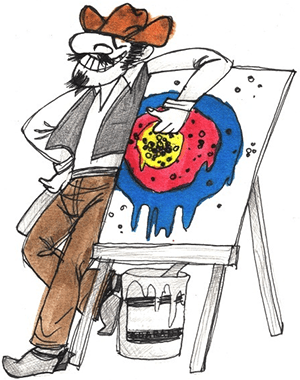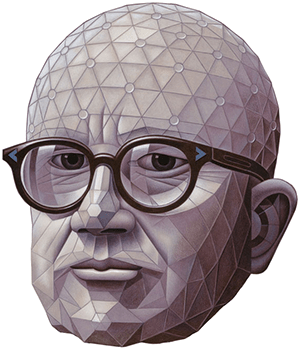The clustering illusion refers to the tendency to erroneously perceive small samples from random distributions as having significant ‘streaks’ or ‘clusters,’ caused by a human tendency to underpredict the amount of variability likely to appear in a small sample of random or semi-random data due to chance. Illusionary clusters were found in the locations of impact of V-1 flying bombs on London during World War II and as streaks in stock market price fluctuations over time.
The clustering illusion was central to a widely reported study by Gilovich, Robert Vallone and Amos Tversky. They found that the idea that basketball players shoot successfully in ‘streaks,’ sometimes called by sportcasters as having a ‘hot hand’ and widely believed by Gilovich et al.’s subjects, was false. In the data they collected, if anything the success of a previous throw very slightly predicted a subsequent miss rather than another success. Using this cognitive bias in causal reasoning may result in the Texas sharpshooter fallacy. It may also have a relationship with gambler’s fallacy. More general forms of erroneous pattern recognition are pareidolia and apophenia.
Clustering Illusion
Texas Sharpshooter Fallacy
The Texas sharpshooter fallacy is a logical fallacy in which information that has no relationship is interpreted or manipulated until it appears to have meaning. The name comes from a joke about a Texan who fires some shots at the side of a barn, then paints a target centered on the biggest cluster of hits and claims to be a sharpshooter.
The fallacy does not apply if one had a prior expectation of the particular relationship in question before examining the data. It is related to the clustering illusion, which refers to the tendency in human cognition to interpret patterns in randomness where none actually exist.
read more »
The Firesign Theatre
The Firesign Theatre is an American comedy troupe consisting of Phil Austin, Peter Bergman, David Ossman and Philip Proctor. Their brand of surrealistic humor is best known through their record albums, which acquired a cult following in the late 1960s and early ’70s. The troupe began as live radio performers in LA; the name stems in part from astrology, because the membership encompasses all three ‘fire signs’: Aries, Leo, and Sagittarius. The name also refers to Fireside Theatre, an early television series that ran on NBC from 1949 to 1955, followed by ‘Jane Wyman Presents the Fireside Theatre’ (1955–58); it may also refer to the Fireside Chats radio broadcasts made by President Franklin Delano Roosevelt, a parody of which can be heard in one of the Theatre’s ‘Nick Danger’ adventures.
The Firesign Theatre employs a stream of consciousness style that includes direct references to movies, radio, TV, political figures, and other cultural sources, intermingled with sound effects and bits of music. The resulting stories — including the theft of a high school, a fair of clowns and holograms and aliens who use hemp smoking to turn people into crows — border on psychedelia, an effect intensified by the frequent appearance of mock ‘advertisements’ satirizing real products. The Firesign approach to comedy was strongly influenced by ‘The Goon Show,’ a British radio comedy program. While their style has the feel of improvisational comedy, most of the material is tightly scripted and memorized. The group’s writing method demands the consent of all four members before a line can be included. Much of their work has been copyrighted under the name ‘4 or 5 Crazee Guys.’
Executive Toy
An executive toy is a novelty item that is usually a small mechanical gadget placed on the desk of a corporate executive or other office workers. They have no work-related function but are usually interesting to look at and entertaining. The first executive toy may have been a gadget designed by the great mathematician and engineer Philo of Byzantium (c.280 BCE), an octagon-shaped ink pot with openings on each side. One could turn the pot so that any face is on top and dip the pen in the opening, but the ink never ran out through the holes on other sides. The inkwell was suspended in the center on a series of gimbals and remained stationary in spite of any rotation.
Examples of executive toys include: EcoSphere (closed Aquarium), Etch A Sketch, Hoberman sphere (a folding and opening geodesic dome), oil and water liquid motion toys, Drinking bird, Magic 8-Ball, mechanical puzzles, music boxes, Nanoblocks (plastic building blocks similar to Lego but about half the linear dimensions), Newton’s cradle (where a set of metal balls are suspended from above, one is pulled from the rest and kicks them, transferring the kinetic energy to the last one), Perpetual pendulum (which doesn’t stop due to an electric magnet in the base of the toy), Pin Art (a box with thousands of small pins of equal length inserted into a board, that can be pressed from one side with any object so that the other ends of the pins form a three-dimensional image of the object on the other side of the board), Rubik’s Cubes, Tops, Yo-yos, Snow globes, Lava lamps, magnet toys, and stress balls.
Buckyballs
Buckyballs are a magnetic toy launched at the New York International Gift Fair in 2009 and sold in the hundreds of thousands before the U.S. Consumer Product Safety Commission issued a recall. In several cases, children swallowed them, and injured their intestines, resulting in at least one death. As a result, regulatory agencies banned them, and the magnets are no longer marketed as toys. This led to a debate over the risks of toys and parental responsibility.
In 2009, a number of US companies decided to repackage sphere magnets and sell them as toys. Despite existing toy regulations at the time, Maxfield & Oberton, maker of Buckyballs, told the ‘New York Times’ that he saw the product on YouTube and repackaged them as Buckyballs. After the recall all mentions of ‘toy’ were changed to ‘desk toy,’ positioning the product as a stress-reliever for adults and restricted sales from stores that sold primarily children’s products.
read more »
Drop City
Drop City was an artists’ community that formed in southern Colorado in 1965. Abandoned by the early 1970s, it became known as the first rural ‘hippie commune.’
In 1965, the four original founders, art students and filmmakers from the University of Kansas and University of Colorado, bought a 7-acre tract of land in south eastern Colorado. Their intention was to create a live-in work of what they called ‘Drop Art’ (sometimes called ‘droppings’), which was informed by the ‘happenings’ of Allan Kaprow and the impromptu performances, a few years earlier, of John Cage, Robert Rauschenberg and Buckminster Fuller, at Black Mountain College.
read more »
Buckminster Fuller
Buckminster Fuller (1895 – 1983) was an American engineer and author. He popularized terms such as ‘Spaceship Earth,’ ephemeralization, and synergetics. He also developed numerous inventions, mainly architectural designs, the best known of which is the geodesic dome. Carbon molecules known as fullerenes were later named by scientists for their resemblance to geodesic spheres.
As a child he had trouble with geometry, being unable to understand the abstraction necessary to imagine that a chalk dot on the blackboard represented a mathematical point, or that an imperfectly drawn line with an arrow on the end was meant to stretch off to infinity. He often made items from materials he brought home from the woods, and sometimes made his own tools.
read more »
Buckypaper
Buckypaper is a thin sheet made from an aggregate of carbon nanotubes. The nanotubes are approximately 50,000 times thinner than a human hair. Originally, it was fabricated as a way to handle carbon nanotubes, but it is also being studied and developed into applications by several research groups, showing promise in vehicle and personal armor and next-generation electronics and displays. It owes its name to the buckminsterfullerene, the 60 carbon fullerene (an allotrope of carbon with similar bonding that is sometimes referred to as a Buckyball in honor of American engineer, Buckminster Fuller.
Buckypaper is one tenth the weight yet potentially 500 times stronger than steel when its sheets are stacked to form a composite. It could disperse heat like brass or steel and it could conduct electricity like copper or silicon.
Buckyball
Discovered in 1965, buckyballs (formally known as buckminsterfullerenes) are hollow spheres made of carbon atoms named after American engineer, Buckminster Fuller (1895 – 1983), who popularized geodesic dome buildings. Buckyballs and nanotubes are an allotrope (structural configuration) of carbon called fullerenes, also after Fuller.
The discovery of fullerenes greatly expanded the number of known carbon allotropes, which until recently were limited to graphite, diamond, and amorphous carbon such as soot and charcoal. Buckyballs and buckytubes have been the subject of intense research, both for their unique chemistry and for their technological applications, especially in materials science, electronics, and nanotechnology.












